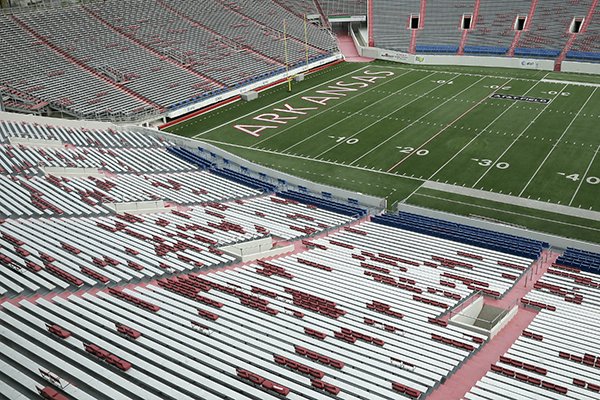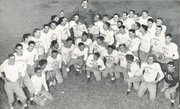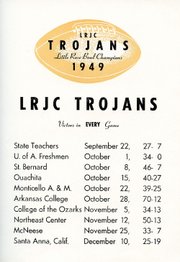The University of Arkansas at Little Rock announced Wednesday plans to study the cost of reviving its football program and whether there would be enough community support.
Several officials said the idea of a college football team in the capital city has buzzed around campus for several years, but no action was taken until some UALR students presented first-year Chancellor Andrew Rogerson with a petition of 1,000 signatures last spring in support of reviving such a program.
"We had to appeal to reason that this is a very expensive endeavor," Rogerson said. "We didn't really have an answer, and we considered ... a feasibility study to make an informed decision on it."
The idea for the study comes at a time when UALR's enrollment has been stagnant and War Memorial Stadium is getting less Razorback football revenue. UALR is exploring using War Memorial Stadium for its football games, and the prospect of having a new tenant offers the stadium, and central Arkansas cities, the potential of additional income.
UALR had a football team when it was a junior college. The school claimed the national football championship in 1949 for junior colleges. The team's final season was in 1955.
UALR will seek proposals from firms to conduct the study, and the school will divide equal parts of the cost with the city of Little Rock and the Arkansas Department of Parks and Tourism. Rogerson said the study should take six to seven months, the estimated total cost will be under $100,000, and UALR's share will be paid with private funds from the athletic department.
A focus of the study, Athletic Director Chasse Conque said, will be how UALR can take in enough revenue to cover the cost of running a football program. Funds for Arkansas intercollegiate athletic programs include donations, student-athletic fees and up to 2 percent in state appropriations. The university won't proceed with a football program if it comes down to using state appropriations.
"That's just not something I would support," Rogerson said. "Hopefully, this will become self-sufficient."
UALR's athletic revenue totaled $11,993,856 from 2015-16 -- 199th in the NCAA and last out of the 11 schools within the Sun Belt Conference. UALR has received assurance from the Sun Belt Conference that if it does create a football team, the team will have a spot within the conference.
UALR is one of the 105 out of 356 (29.5 percent) schools within NCAA Division I that does not have a football team. The University of Texas at Arlington, which is second-to-last in total revenue in the Sun Belt Conference, is the only other school in the conference that also does not have a football program.
The other universities within the Sun Belt Conference that do have football programs have budgets more than double that of UALR.
"It's a huge commitment by the schools to do it if you don't already have football," said UT-Arlington Athletic Director Jim Baker, whose university conducted a feasibility study three years ago before deciding to stop pursuing a football program when it found that it would cost $10 million to start.
The high cost is why the University of Alabama at Birmingham stopped playing football in 2014. The team is returning this season.
"Everything you have to add to have a football team -- the infrastructure, not just facilities but staff-wise," Baker said. "We didn't have a large sports medicine group, the ticketing, the development, sponsorship staffs -- people you don't even think about. You're going to have a lot of cost to get it going."
The athletic department budget will have to line up. The Arkansas Code Annotated 6-62-804 says that colleges and universities cannot operate under deficits in athletic programs. The state allows higher-education institutions to take in money from unrestricted education and general revenue, which is usually for academics, and from auxiliary profits, such as housing or food services. But the schools cannot transfer more than 2 percent of their unrestricted education and general revenue into their athletics departments.
If an institution has a deficit after totaling athletic revenue and other income, private gifts and transfers from auxiliary or education and general funds, it must charge a designated student fee.
The Football Bowl Subdivision schools with higher budgets depend less on student fees than subdivision schools that have lower budgets. (The subdivision includes large schools such as the University of Alabama or the University of Arkansas, Fayetteville.)
According to a 2014 report from the Knight Commission on Intercollegiate Athletics, the subdivision schools that spend $12 million-$29 million on athletics use 1̶4̶ ̶p̶e̶r̶c̶e̶n̶t̶ 32 percent* more from student fees than subdivision schools that spend $88 million-$154 million. The Knight Commission is based in Florida and encourages intercollegiate athletics programs to operate within their schools' educational missions.
UA-Fayetteville is the only public university in Arkansas that does not charge students athletic fees.
In 2015-16 -- the most recent year for which an athletic budget report is available from the state Department of Higher Education -- UALR charged its 11,891 students $18.75 per credit hour in athletic fees. The university raised $3,837,889 from it.
By comparison, Arkansas State University with its 13,410 students that same year collected a little more than $5 million in student-athletic fees and $1,762,021 in ticket sales, about $1.4 million from football, data show. The Jonesboro university, a Sun Belt team, has also charged an athletic fee of $19 per credit hour since at least 2015-16.
UALR earned $4,097,305 from student-athletic fees last year when it charged $20 per credit hour. It will charge students $21 per credit hour for the 2017-18 academic year.
A football team at UALR could attract more students and, in turn, raise more in student-athletic fee revenue, Rogerson said. The university has set a "15 in 5" goal -- getting to 15,000 students by 2022. In the fall of 2016, 11,665 students were enrolled at the university, down nearly 10 percent from five years ago.
Whatever the student-athletic fees eventually total, UALR will look to pay the rest of the cost with donations and game revenue such as ticket sales.
In 2016, UALR took in $537,051 in donations to the university specifically for athletics, and $486,269 in ticket sales, mostly from men's basketball games, according to state data.
Larry Golden, a 1982 UALR graduate and former swimmer, deferred to the coming feasibility study in regards to whether the alumni base could help financially support a football team's expenses, but he believed there would be enough local interest to generate ticket sales.
"Imagine a game between Little Rock and Arkansas State at War Memorial Stadium," said Golden, who sits on the UALR athletic advisory board. "What kind of draw would that have?"
Arkansas Gov. Asa Hutchinson said through his spokesman J.R. Davis that he supports the study, and Little Rock Mayor Mark Stodola said that another college football team in Arkansas would not flood the sports market.
"I'm an alumnus of UA-Fayetteville," Stodola said. "I support the Razorbacks, and this is just a natural evolution for UA-Little Rock. It's a process that doesn't happen overnight. But long term for the city, it has some great possibilities. "
UALR has relied on donations to support athletic ventures. The university was able to construct a new basketball arena for the 2005-06 season because of a $22.4 million gift from the late businessman Jackson T. Stephens, and in January 2016, the Coleman family, owners of the former Coleman Dairy company, agreed to donate nearly 8 acres for the university to build a new baseball field and sports complex.
The Razorbacks have played football games at War Memorial Stadium since 1948. Under its current agreement with War Memorial Stadium, UA-Fayetteville will play one game in the Little Rock stadium through the 2018 season. It is unknown what will happen afterward.
UA Athletic Director "Jeff Long has to make some decisions on football games at War Memorial, and there may be some value in this process in how this decision is made," Stodola said.
The state-owned stadium is run by the Arkansas Department of Parks and Tourism and currently rents out its facility for several athletic events.
"The more the merrier. We can accommodate all of them," said Kane Webb, the agency's director. He would not say what the department would charge UALR and deferred to the outcome of the study.
"We just know that we would love [for them to be a tenant] if it should happen. This study is the first step of this process."
A Section on 07/13/2017
*CORRECTION: According to a 2014 report from the Knight Commission on Intercollegiate Athletics, the Football Bowl Subdivision schools that spend $12 million-$29 million on athletics use 32 percent more from student fees than subdivision schools that spend $88 million-$154 million. A previous version of this article incorrectly reported the percentage.


